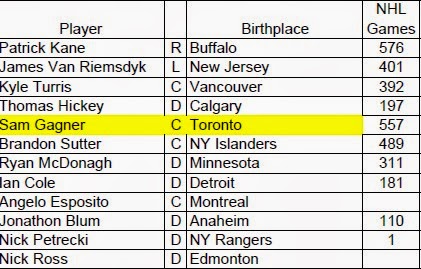In
my previous article (How to Rectify the NHL Draft Lottery) I
put forth a proposal on how to rectify what I see as the issues with
the current NHL Draft Lottery. My proposal was to give each NHL team
what I call a Protected Draft Territory or P.D.T.
In
that previous article, I listed the initial misgivings I had with my
proposal – that it would bestow an unfair advantage on the NHL’s
Canadian teams because of their proximity to large amateur hockey
leagues and unfairly penalize the NHL’s U.S. teams because of their
perceived lack of amateur hockey leagues in their vicinity. But as
you will see in this article, the application of the P.D.T. to the
year 2007 did not result in any discernible level of advantage or
disadvantage.
At this point I’ll quickly rehash the
three P.D.T. rules that I applied to the 2007 NHL Entry Draft:
- A player’s birth place, not his last amateur hockey team before becoming eligible for the NHL Entry Draft, determined which P.D.T., if any, the player would be eligible for.
- Where more than one NHL team shares a natural territory (such as a province or a state), how close a player’s birth place is to an NHL team determined which P.D.T. the player would be eligible for.
- As each player was removed from the original entry draft because of designation under the P.D.T., the players below the removed player were moved up in the draft order. This seems rather arbitrary. But without any knowledge of what each team would have drafted had the player they originally drafted not been available, it seems like a fair compromise. So, for example, if the first player chosen in the original entry draft had been designated under the P.D.T., the second player chosen in the original entry draft was moved up to the first player chosen in the revised entry draft.
As
in each of the previous years, the application of the three simple
rules above may have altered the history of the NHL as we know it. A
few key players on Cup winning teams might not have been there to
help those teams win their Cups or perhaps might have helped their
new teams win a Cup instead.
Table
1 below is actually two tables in one. The first six columns
represent how the original NHL Entry Draft played out. The second six
columns represent how a revised NHL Entry Draft might have transpired
after the application of the P.D.T. rules.
Table
1.
The
Entry Draft for 2007 turned out to be another draft where the level
of talent was quite high. Even after a record twelve players from the
1st round would have been designated under the P.D.T.,
there are more than a few recognizable names from the original 2007
Entry Draft. For example, Patrick Kane, James Van Riemsdyk, Kyle
Turris, Sam Gagner, Jakub Voracek, Logan Couture, Brandon Sutter,
Ryan McDonagh, Lars Eller, Kevin Shattenkirk, and Max Pacioretty.
Even
though they had, once again, traded away their first round pick in
the 2007 Entry Draft, the Maple Leafs would still have been able to
secure, via designation of their P.D.T., another good player –
Sam Gagner.
With
all four of the original picks being designated under the P.D.T., the
picks in the revised draft would have been extremely different. For
example, Jakub Voracek, Logan Couture, Lars Eller, Kevin Shattenkirk,
and Max Pacioretty would have all been drafted by different teams.
By
looking closely at Table 1 above, we can see the players in Table 2
below are the players from the first round of the draft who would
have been eligible for designation under the P.D.T. rule and
therefore would have started their careers with and played for
different teams:
Table
2.
The
casual fan, looking at the names from Table 2, would find the list
about evenly split between recognizable and less recognizable names.
From
that same list of names above, the one having interest for Maple
Leafs fans would, of course, be Sam Gagner. The obvious question:
- Does Sam Gagner provide the depth down the middle to help the Maple Leafs win a Cup?
As
intriguing as that question is, the answer will never be known.
As
was the case for the revised Entry Drafts from 2000 the revised Entry
Draft for 2007 provides many questions for endless speculation,
discussion, and debate.


No comments:
Post a Comment